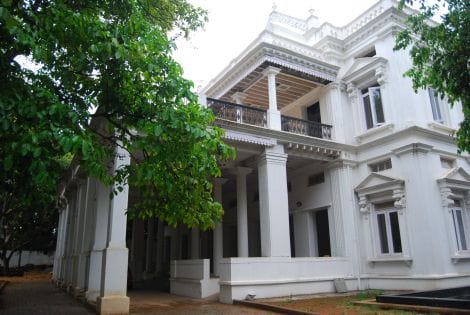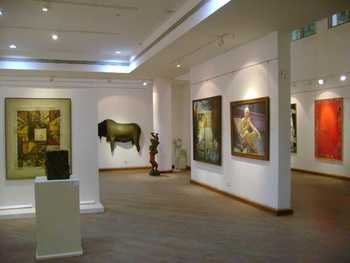Sobha Nambisan is 1976 batch IAS officer (retired) and took over the reins of NGMA Bengaluru in May 2010. After retiring from the IAS, she has been at the helm of affairs at NGMA.
NGMA, Bangalore was long-awaited and fought for by the artists community in the state before it finally opened in the city in early 2009. It’s entry fee is Rs.10 and all events are free to the public. It is the central government’s third such gallery and first one in south India. New Delhi and Mumbai have the other national galleries.
Sobha Nambisan talks to Subramaniam Vincent about her journey so far and what NGMA has managed to achieve in the short period that she’s been at the helm. Sobha says she has always been interested in art. She has been drawing, sketching and painting as a hobby.

Sobha Nambisan, Director, NGMA. Pic: Subramaniam Vincent.
How has your tenure been so far?
I don’t think I have sunk my teeth in to the institution but I think we have done a lot to make it alive. It has become a centre for art and culture, there have been continuous programmes, and people have come to know about this place. We are in the process of planning and holding a lot of exhibitions. We have film shows every weekend, we have talks, and we have school education programmes. More than 80 schools have visited us already. We have programmes tailor made for each school grade.
We are joining up with other organisations like British Council, the ICCR, Bangalore Film Society and India Foundation for the Arts. It has become a live place, especially during the weekends. So I think to that extent in a very short period of time we have been able to do something. There’s a great deal yet to be done but we are on the right track.

NGMA is at the lovely Manikyavelu Mansion on Palace Road, Vasanthnagar. File pic: Amoghavarsha J S.
Is there a focus on Bangalore and Karnataka because it is situated here?
I don’t think NGMA is just for Bangalore. It is a national gallery of modern art. It is meant for the country as a whole and the southern region in particular. Our advisory committee, they come from all the southern states and not just from Bangalore.
Is NGMA accessed only by the elite?
It’s open for all, ten rupees a ticket. Is that a lot of money?
We have a regular programme for government schools (around 30). Every Friday, a government school comes here.
We don’t merely take the children around. We have a programme. If you go there you will see a board on which we have pinned the drawings of children who have visited. We do reach out to who you call, ‘the non-english speaking’ people. We don’t make that distinction, I don’t think we should.
I have tried to speak to the government to allocate more funds so that more schools come. There are so many corporation schools (in Bangalore).
As far as the auditorium programmes are concerned, they are very well attended. Somehow, (I am not saying well-to-do people or poor people,) there’s not as much interest in visual art as there may be in music, dance and theatre so the number of people who visit our gallery is not that substantial from whichever income category. But the number is increasing.

‘Signposts of the Times..’ show that ran in the contemporary art section at the ground floor. File pic: Krishna Prasad, NGMA.
Most of the time people are involved in earning their daily bread and on Sunday they would like to relax and take their children to a mall or something, painting gallery is not a first choice perhaps. I think our educational system itself does not give much importance to drawing, painting and art.
Do you feel NGMA needs more publicity? Not enough people seem to know about it.
I think we do need some more publicity but at the same time I think, see why many people have not heard about is because for the first one year we did precious little, there was no director here, no staff, nothing had happened. It’s only in the last one year that something has happened.
Also it’s not that everybody is interested in these things either. Those who are interested would have come to know.
Has it happened with the 30 schools that have come? Did any of the kids come back on their own with their parents?
They haven’t done that. What they have left behind are their drawings which you can see.
So that loop hasn’t closed yet…
NGMA entry: Rs.10 entry, events are free
It’s a place where for just a ten rupee ticket; you can see paintings and sculptures inside. Then they can join for any programme. Film shows, talks.
Gallery walks are also free
Assistant curators take people around the galleries and describe the paintings. There are two regular gallery walks every week – one on Wednesdays at 3 pm there’s one on ‘Elements of art’ and on Saturday at 10 30 there’s one on ‘History of Indian art’.
Cafeteria
The NGMA cafeteria has snacks and tea/coffee. It is run by the same person run the Rangashankara cafeteria at JP Nagar.
Again, let me ask you Subbu, we find it with not just poorer people but also with IT professionals. They are drained dry at the end of the week. Their weekend is spent in catching up with sleep and chores and so on and so forth. They don’t find time.
Art comes when you have met with your material basic needs, then you turn to art.
Lots of people visit nearby malls, which have atriums, and activities.. People are going there because they do some shopping, they might watch a movie but they also ‘chill out’ there. Aren’t they also an audience for NGMA?
That is very much true. You can ‘chill out’ here too. NGMA gives Bangaloreans a place where they can have a variety of experiences, all pleasurable and most of them free. The can sit and have a meal here. They can walk around; they can see the paintings, enjoy the film show. It’s an aesthetic alternative to mall culture. There’s also plenty of space for parking cars.
Most of the things you do in a mall, you can do here, except shopping but that is a necessity. But then think of it, most of the malls are not far away from home. They are near, but NGMA is just one place and coming from Whitefield or from Electronic City and so on to NGMA is not easy.
How many visitors have you had in all? A rough figure?
For example, for this contemporary photography exhibition (held in February over a week) it was slightly less than 2,000.
Switching topics, Will you host someone like M F Hussain?
Why not? We would be lucky and happy to host him here. We have no issues. But our exhibitions are curated shows. You have to spend money and pay the curators and for publications and so the estimates are to be approved and so on. In other words it’s not just our organisation that has to do it alone.
The committee does not have the financial power; they are just an advisory body. It is the Ministry (New Delhi) that has to approve it.

Sobha Nambisan, Director, NGMA. Pic: Subramaniam Vincent.
Is there a local context to the exhibits? Will there be more of artistes from South India or from Karnataka?
No. As far this permanent collection is concerned, it’s all from NGMA Delhi. NGMA Delhi send repository of paintings to NGMA. They have some 17,000 paintings and we have about 500. This when the place was inaugurated, they had sent these paintings as a kind of representation of what they have and then they had had curated it and hung it up.
But at the same time, we are going to have an exhibition on K K Hebbar and Gurumale Chennabasavayya both of whom are from Karnataka. It just happens that both of them are having a birth centenary, which also is a reason. Also they are from Karnataka so we are still more interested in that.
How does an artist bring their show to you?
What we are doing now for the artists is a special initiative called "Carte Blanche". We have written to all the artists saying that they can give performances in the grounds of NGMA. Recently Shyamala Nandish had given a performance.
Soon after I joined here in May 2010, we had a meeting with some 60 or 70 artists from Bangalore and we had explained and we had asked for suggestions on how to develop this place.
Let me just close with one question. What are the constraints you have in actually running NGMA?
We would like to pay a higher amount to our speakers to hold art appreciation workshops. We pay them now, but we would like to treat them a little more generously. Maybe have a regular you know coffee/ tea before the talk.
I think we are fairly happy as we go along. I think it’s a question of time. Ideas are coming to us. We’ve got a lot of friends now with other organisations.
We have been joined with IFA- Indian Foundation for the Arts or with Bangalore Film Society or British Council or with Art Resources and Teaching or with Sarvodaya International or with this Travelling South Asia film. So far we have not found that a constraint and we do get interesting things out of it.
What is your total team size here? (excluding security and ancillary staff)
Around 13-14-15 people.
And do you find that enough?
"You can chill out here. You have food, a beautiful place to sit down and you can see a movie. Most of the things you do in a mall, you can do here."
In fact the VNB people, the Victorian art people who came here, they were astonished that we were doing so many things with such a small number of people. They were saying that they would need three times that number to do this for the amount of work that we were doing.
We may need a few people as we go along – more curators and so on. We have two assistant curators who are on contract basis. Both cannot speak Kannada so we’re not able to regularly organise Kannada gallery walks like we do in English.
Most of us are on contract basis . We also need people to do research on the paintings we have. ⊕